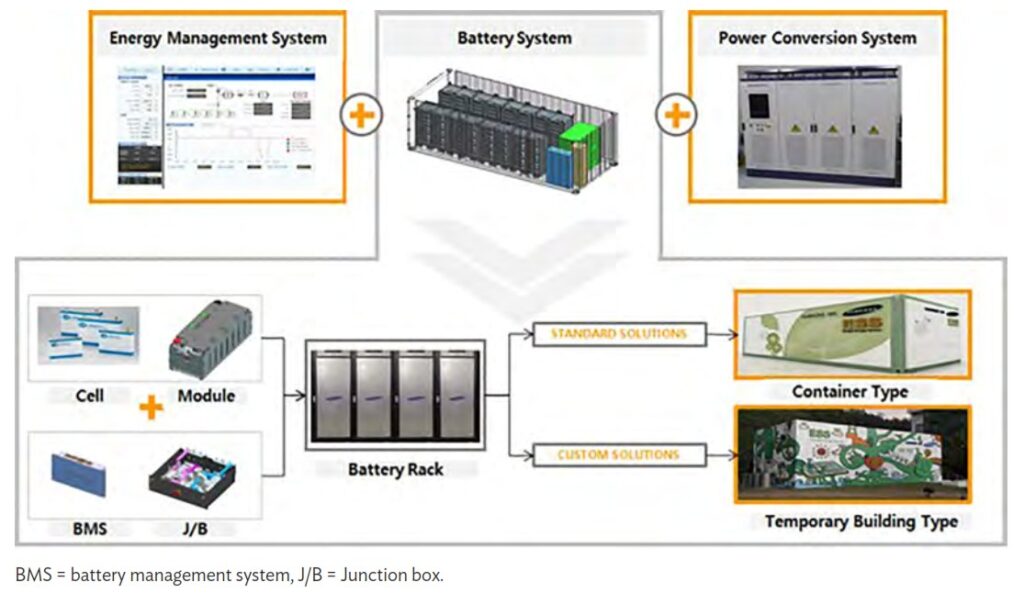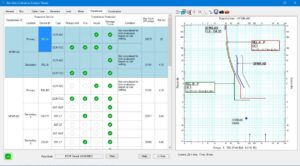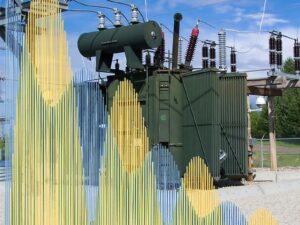A BESS is a Battery Energy Storage System that captures energy from different sources, accumulates this energy, and stores it in rechargeable batteries for later use.
The battery discharges the electrochemical energy and supplies to homes, electric vehicles, industrial and commercial facilities.
Below figure schematic shows the various components of a battery energy storage system:

1. Energy Storage System Components
Battery components, components required for reliable system operation, and grid connection components are the group components for ESS.

The battery system consists of the battery pack, which connects multiple cells to appropriate voltage and capacity; the battery management system (BMS); and the battery thermal management system (B-TMS).
The BMS protects the cells from harmful operation, in terms of voltage, temperature, and current, to achieve reliable and safe operation, and so balances varying cell states-of-charge (SOCs) within a serial connection.
The B-TMS controls the temperature of the cells according to their specifications in terms of absolute values and temperature gradients within the pack.
The components required for the reliable operation of the overall system are system control and monitoring, the energy management system (EMS), and system thermal management.
System control and monitoring is general (IT) monitoring, supervisory control and data acquisition (SCADA) system. However, it may also include fire protection or alarm units.
The EMS is responsible for system power flow control, management, and distribution. System thermal management controls all functions related to the heating, ventilation, and air-conditioning of the containment system.
The power electronics can be grouped into the conversion unit, which converts the power flow between the grid and the battery, and the required control and monitoring components – voltage sensing units and thermal management of power electronics components (fan cooling).
2. Grid Connection For Utility-Scale BESS Projects
Below figure gives an overview of grid connection topologies for utility-scale BESS, which typically consist
of multiple battery packs and inverter units, all adding up to the total system energy and power.
Power electronics units dedicated to individual battery packs can be installed (Figure-(a)) or the battery packs can be connected in parallel to a common direct-current (DC) bus (Figure-(b)). Figure-(c) shows an example of grid connection to a low-voltage level, and Figure-(d), connection to higher grid levels via a
transformer.

3. Types of Batteries
(a) Lead-Acid (PbA) Battery
This type of secondary cell is widely used in vehicles and other applications requiring high values of load current. Its main benefits are low capital costs, maturity of technology, and efficient recycling.



(b) Nickel-Cadmium (Ni-Cd) Battery
A nickel-cadmium battery (Ni-Cd) is a rechargeable battery. Portable computers, drills, camcorders, and other small battery-operated devices use such type of batteries.

(c) Nickel-Metal Hydride (Ni-MH) Battery
The Ni–MH battery combines the proven positive electrode chemistry of the sealed Ni–Cd battery with the energy storage features of metal alloys developed for advanced hydrogen energy storage concepts.
Ni–MH batteries outperform other rechargeable batteries, and have higher capacity and less voltage depression.
The Ni–MH battery is used in high-end portable electronic products, where battery performance parameters, notably run time, are major considerations in the purchase decision.

(d) Lithium-Ion (Li-Ion) Battery
Li-ion battery chemistries have the highest energy density and considered as safe.
Electronic devices (cameras, calculators, laptop computers, and mobile phones) and electrical mobility use Li-Ion batteries.









